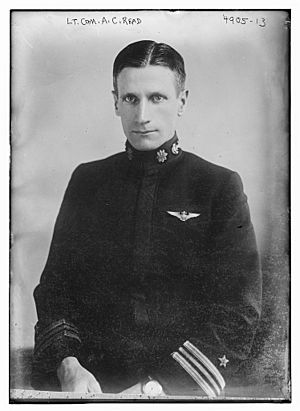Albert Cushing Read facts for kids
Quick facts for kids
Albert Cushing Read, Sr.
|
|
|---|---|

Read in 1919
|
|
| Born | March 29, 1887 Lyme, New Hampshire, US |
| Died | October 10, 1967 (aged 80) Coconut Grove, Florida, US |
| Place of burial | |
| Allegiance | |
| Service/ |
|
| Years of service | 1907–1946 |
| Rank | |
| Battles/wars | World War I World War II |
| Awards | Distinguished Service Medal Legion of Merit NC-4 Medal |
Albert Cushing Read, Sr. (born March 29, 1887 – died October 10, 1967) was a brave pilot and a high-ranking officer, a Rear Admiral, in the United States Navy. He is famous for leading the very first team to fly across the Atlantic Ocean! They made this amazing journey in a special airplane called the NC-4, which was a type of flying boat.
Contents
Early Life and Amazing Flights
Albert Cushing Read was born in Lyme, New Hampshire, on March 29, 1887. He went to the United States Naval Academy at Annapolis, graduating in 1907. By 1915, he became one of the first naval aviators, meaning he was trained to fly for the Navy.
First Flight Across the Atlantic
In May 1919, when he was a Lieutenant Commander, Read led a team of five people on the NC-4 flying boat. This was the very first aircraft to ever fly across the Atlantic Ocean! This incredible journey happened a few weeks before another famous non-stop flight by Alcock and Brown. It was also eight years before Charles Lindbergh's famous solo flight.
Read's flight started from Rockaway Beach, Long Island. The whole trip took 23 days before they finally arrived in Plymouth, England. Along the way, they made six stops to refuel and rest. These stops included places like Trepassey Bay, Newfoundland, the Azores, and Lisbon, Portugal.
A Look into the Future
After returning to the U.S. in 1919, Read made a bold prediction. He said that soon, airplanes would be able to fly around the world. He even thought they could fly at 60,000 feet high and go 1,000 miles per hour!
The next day, The New York Times newspaper wrote about his prediction. They thought it was impossible at the time. They said an airplane couldn't fly that high because there wouldn't be enough air for the propellers. They also worried about how cold it would be.
Special Awards and Honors
On June 3, 1919, the government of Portugal honored Read. They made him a commander of the Order of the Tower and Sword. This was a very special award.
After he returned to the United States, Read received the Navy Distinguished Service Medal. This was a very important award at the time. The other five crew members of the NC-4 received the Navy Cross. Later, in 1929, Read and the entire flight crew of the NC-4 were also given Congressional Gold Medals.
On June 24, 1924, Commander Read took charge of two things. He commanded the ship USS Ajax and also the aircraft squadrons of the United States Asiatic Fleet. He stayed in this role for about a year.
Read continued to be an important figure in the Navy. He helped train many naval aviators, or Navy pilots, all the way through World War II. He was known by the nickname "Putty Read." People called him this because his face rarely showed much emotion.
On June 4, 1962, he appeared on a TV game show called I've Got a Secret.
Albert Cushing Read retired from the Navy. He passed away in Coconut Grove, Florida, on October 10, 1967. He is buried in Arlington National Cemetery with his wife, Bess Burdine Read.
Awards
- Congressional Gold Medal
- Navy Distinguished Service Medal
- NC-4 Medal
- World War I Victory Medal
- American Defense Service Medal
- American Campaign Medal
- Commander of the Order of the Tower and Sword
- Air Force Cross (United Kingdom)
- World War II Victory Medal

